Simulation Methodology Based on Wind and Thermal Performance for Early Building Optimization Design in Taiwan
Abstract
:1. Introduction
2. Methodology
2.1. BPO Workflow
2.2. Platform and Tools
2.3. Evaluation Indicators
2.3.1. Step 1
- Outdoor Sunlight Density
- Annual Building Radiation Density
2.3.2. Step 2
- Building Natural Ventilation Potential
- Pedestrian Wind Comfort Ratio
- Outdoor PET Comfort Ratio
3. Case Study and Results
3.1. Case Description
3.2. Step 1: Primary Building Massing
3.2.1. Design Variations
3.2.2. Simulation and MOO Setting
3.2.3. Results of Step 1
3.3. Step 2: Massing Adjustment and Opening
3.3.1. Subsubsection
3.3.2. Simulation and MOO Setting
3.3.3. Results of Step 2
4. Discussion and Conclusions
Author Contributions
Funding
Conflicts of Interest
References
- Tian, Z.; Zhang, X.; Jin, X.; Zhou, X.; Si, B.; Shi, X. Towards adoption of building energy simulation and optimization for passive building design: A survey and a review. Energy Build. 2018, 158, 1306–1316. [Google Scholar] [CrossRef]
- Hensen, J.L.M.; Lamberts, R. (Eds.) Building Performance Simulation for Design and Operation, 2nd ed.; Routledge: London, UK, 2019. [Google Scholar] [CrossRef]
- Basic, S.; Hollberg, A.; Galimshina, A.; Habert, G. A design integrated parametric tool for real-time Life Cycle Assessment—Bombyx project. IOP Conf. Series Earth Environ. Sci. 2019, 323, 012112. [Google Scholar] [CrossRef]
- Zhao, Y.; Ducharne, A.; Sultan, B.; Braconnot, P.; Vautard, R. Estimating heat stress from climate-based indicators: Present-day biases and future spreads in the CMIP5 global climate model ensemble. Environ. Res. Lett. 2015, 10, 084013. [Google Scholar] [CrossRef] [Green Version]
- Abdel-Ghany, A.M.; Al-Helal, I.M.; Shady, M.R. Human Thermal Comfort and Heat Stress in an Outdoor Urban Arid Environment: A Case Study. Adv. Meteorol. 2013, 2013, 1–7. [Google Scholar] [CrossRef] [Green Version]
- De Oliveira, C.C.; Rupp, R.F.; Ghisi, E. Influence of environmental variables on thermal comfort and air quality perception in office buildings in the humid subtropical climate zone of Brazil. Energy Build. 2021, 243, 110982. [Google Scholar] [CrossRef]
- Haase, M.; Amato, A. An investigation of the potential for natural ventilation and building orientation to achieve thermal comfort in warm and humid climates. Sol. Energy 2009, 83, 389–399. [Google Scholar] [CrossRef]
- Cheng, V.; Ng, E.; Chan, C.; Givoni, B. Outdoor thermal comfort study in a sub-tropical climate: A longitudinal study based in Hong Kong. Int. J. Biometeorol. 2011, 56, 43–56. [Google Scholar] [CrossRef]
- Chen, Y.; Tong, Z.; Malkawi, A. Investigating natural ventilation potentials across the globe: Regional and climatic variations. Build. Environ. 2017, 122, 386–396. [Google Scholar] [CrossRef]
- Etheridge, D. Natural Ventilation of Buildings; John Wiley & Sons: Chichester, UK, 2011. [Google Scholar] [CrossRef]
- Mishra, A.K.; Ramgopal, M. A thermal comfort field study of naturally ventilated classrooms in Kharagpur, India. Build. Environ. 2015, 92, 396–406. [Google Scholar] [CrossRef]
- Kim, J.; de Dear, R. Impact of different building ventilation modes on occupant expectations of the main IEQ factors. Build. Environ. 2012, 57, 184–193. [Google Scholar] [CrossRef] [Green Version]
- Garde, F.; Ottenwelter, E.; Bornarel, A. Integrated Building Design in Tropical Climates: Lessons Learned from the ENERPOS Net Zero Energy Building. ASHRAE Trans. 2012, 118, 81–89. [Google Scholar]
- Rodriguez-Ubinas, E.; Montero, C.; Porteros, M.; Vega, S.; Navarro, I.; Castillo-Cagigal, M.; Matallanas, E.; Gutiérrez, A. Passive design strategies and performance of Net Energy Plus Houses. Energy Build. 2014, 83, 10–22. [Google Scholar] [CrossRef] [Green Version]
- Yang, W.; Zhang, G. Thermal comfort in naturally ventilated and air-conditioned buildings in humid subtropical climate zone in China. Int. J. Biometeorol. 2007, 52, 385–398. [Google Scholar] [CrossRef]
- Carlucci, S.; Pagliano, L. A review of indices for the long-term evaluation of the general thermal comfort conditions in buildings. Energy Build. 2012, 53, 194–205. [Google Scholar] [CrossRef]
- ASHRAE. Standard 62.1-2013 Ventilation for Acceptable Indoor Air Quality; American Society of Heating, Refrigerating and Air-Conditioning Engineers, Inc.: Atlanta, GA, USA, 2013; p. 40. [Google Scholar]
- Awbi, H. Ventilation of Buildings; Routledge: London, UK, 2002. [Google Scholar]
- Xing, H.; Hatton, A.; Awbi, H. A study of the air quality in the breathing zone in a room with displacement ventilation. Build. Environ. 2001, 36, 809–820. [Google Scholar] [CrossRef]
- Wang, B.; Malkawi, A. Design-based natural ventilation evaluation in early stage for high performance buildings. Sustain. Cities Soc. 2019, 45, 25–37. [Google Scholar] [CrossRef]
- Isyumov, N.; Davenport, A.G. The ground level wind environment in built-up areas. In Proceedings of the 4th International Conference on Wind Effects on Buildings and Structures, Heathrow, London, UK; 1975; pp. 403–422. [Google Scholar]
- Lawson, T. The widn content of the built environment. J. Wind Eng. Ind. Aerodyn. 1978, 3, 93–105. [Google Scholar] [CrossRef]
- Melbourne, W. Criteria for environmental wind conditions. J. Wind Eng. Ind. Aerodyn. 1978, 3, 241–249. [Google Scholar] [CrossRef]
- Willemsen, E.; Wisse, J.A. Design for wind comfort in The Netherlands: Procedures, criteria and open research issues. J. Wind Eng. Ind. Aerodyn. 2007, 95, 1541–1550. [Google Scholar] [CrossRef]
- Du, Y.; Mak, C.M.; Kwok, K.; Tse, K.-T.; Lee, T.-C.; Ai, Z.; Liu, A.J.; Niu, J. New criteria for assessing low wind environment at pedestrian level in Hong Kong. Build. Environ. 2017, 123, 23–36. [Google Scholar] [CrossRef] [Green Version]
- Enescu, D. A review of thermal comfort models and indicators for indoor environments. Renew. Sustain. Energy Rev. 2017, 79, 1353–1379. [Google Scholar] [CrossRef]
- Fantozzi, F.; Rocca, M. An Extensive Collection of Evaluation Indicators to Assess Occupants’ Health and Comfort in Indoor Environment. Atmosphere 2020, 11, 90. [Google Scholar] [CrossRef] [Green Version]
- Höppe, P. The physiological equivalent temperature–a universal index for the biometeorological assessment of the thermal environment. Int. J. Biometeorol. 1999, 43, 71–75. [Google Scholar] [CrossRef] [PubMed]
- Broede, P.; Fiala, D.; Blazejczyk, K.; Holmér, I.; Jendritzky, G.; Kampmann, B.; Tinz, B.; Havenith, G. Deriving the operational procedure for the Universal Thermal Climate Index (UTCI). Int. J. Biometeorol. 2011, 56, 481–494. [Google Scholar] [CrossRef] [Green Version]
- Pickup, J.; de Dear, R. An outdoor thermal comfort index (OUT_SET*)-part I-the model and its assumptions. In Biometeorology and Urban Climatology at the Turn of the Millennium; de Dear, R.J., Kalma, J.D., Oke, T.R., Auciliems, A., Eds.; WMO: Geneva, Swizterland, 2000; pp. 279–283. [Google Scholar]
- Matzarakis, A.; Amelung, B. Physiological Equivalent Temperature as Indicator for Impacts of Climate Change on Thermal Comfort of Humans. In Seasonal Forecasts, Climatic Change and Human Health; Springer Science and Business Media: Berlin, Germany, 2008; pp. 161–172. [Google Scholar]
- Blazejczyk, K.; Jendritzky, G.; Bröde, P.; Fiala, D.; Havenith, G.; Epstein, Y.; Psikuta, A.; Kampmann, B. An introduction to the Universal Thermal Climate Index (UTCI). Geogr. Pol. 2013, 86, 5–10. [Google Scholar] [CrossRef] [Green Version]
- Gibberd, J. Assessing sustainable buildings in developing countries–the sustainable building assessment tool (SBAT) and the sustainable building lifecycle (SBL). In Proceedings of the World Sustainable Building Conference, Tokyo, Japan, 27–29 September 2005. [Google Scholar]
- Si, B.; Tian, Z.; Jin, X.; Zhou, X.; Tang, P.; Shi, X. Performance indices and evaluation of algorithms in building energy efficient design optimization. Energy 2016, 114, 100–112. [Google Scholar] [CrossRef]
- Attia, S.; Hamdy, M.; O’Brien, W.; Carlucci, S. Assessing gaps and needs for integrating building performance optimization tools in net zero energy buildings design. Energy Build. 2013, 60, 110–124. [Google Scholar] [CrossRef] [Green Version]
- Touloupaki, E.; Theodosiou, T. Performance Simulation Integrated in Parametric 3D Modeling as a Method for Early Stage Design Optimization—A Review. Energies 2017, 10, 637. [Google Scholar] [CrossRef] [Green Version]
- Evins, R. A review of computational optimisation methods applied to sustainable building design. Renew. Sustain. Energy Rev. 2013, 22, 230–245. [Google Scholar] [CrossRef]
- Lin, B.; Chen, H.; Yu, Q.; Zhou, X.; Lv, S.; He, Q.; Li, Z. MOOSAS—A systematic solution for multiple objective building performance optimization in the early design stage. Build. Environ. 2021, 200, 107929. [Google Scholar] [CrossRef]
- Kämpf, J.H.; Robinson, D. Optimisation of building form for solar energy utilisation using constrained evolutionary algorithms. Energy Build. 2010, 42, 807–814. [Google Scholar] [CrossRef]
- Delgarm, N.; Sajadi, B.; Delgarm, S. Multi-objective optimization of building energy performance and indoor thermal comfort: A new method using artificial bee colony (ABC). Energy Build. 2016, 131, 42–53. [Google Scholar] [CrossRef]
- Zhang, A.; Bokel, R.; Dobbelsteen, A.V.D.; Sun, Y.; Huang, Q.; Zhang, Q. Optimization of thermal and daylight performance of school buildings based on a multi-objective genetic algorithm in the cold climate of China. Energy Build. 2017, 139, 371–384. [Google Scholar] [CrossRef]
- Carlucci, S.; Cattarin, G.; Causone, F.; Pagliano, L. Multi-objective optimization of a nearly zero-energy building based on thermal and visual discomfort minimization using a non-dominated sorting genetic algorithm (NSGA-II). Energy Build. 2015, 104, 378–394. [Google Scholar] [CrossRef] [Green Version]
- Talaei, M.; Mahdavinejad, M.; Azari, R.; Prieto, A.; Sangin, H. Multi-objective optimization of building-integrated microalgae photobioreactors for energy and daylighting performance. J. Build. Eng. 2021, 42, 102832. [Google Scholar] [CrossRef]
- Lin, S.-H.E.; Gerber, D.J. Designing-in performance: A framework for evolutionary energy performance feedback in early stage design. Autom. Constr. 2014, 38, 59–73. [Google Scholar] [CrossRef]
- Davidson, S. Grasshopper: Algorithmic Modelling for Rhino 2019. Available online: http://www.grasshopper3d.com/ (accessed on 21 January 2021).
- Ladybug Tools LLC. Ladybug Tools. Available online: https://www.ladybug.tools/ladybug.html (accessed on 12 August 2021).
- Jakubiec, J.A.; Reinhart, C.F. DIVA 2.0: Integrating daylight and thermal simulations using Rhinoceros 3D, DAYSIM and EnergyPlus. In Proceedings of the Building Simulation, Sydney, Australia, 14–16 November 2011. [Google Scholar]
- Advanced Knowledge Laboratory, Inc. CFD Simulation for Architectural Design. Available online: http://www.akl.co.jp/en/ (accessed on 1 April 2020).
- Wallicei. An Evolutionary Multi-Objective Optimization and Analytic Engine for Grasshopper 3D. Available online: https://www.wallacei.com/ (accessed on 12 August 2021).
- Deb, K.; Pratap, A.; Agarwal, S.; Meyarivan, T. A fast and elitist multiobjective genetic algorithm: NSGA-II. IEEE Trans. Evol. Comput. 2002, 6, 182–197. [Google Scholar] [CrossRef] [Green Version]
- Si, B.; Wang, J.; Yao, X.; Shi, X.; Jin, X.; Zhou, X. Multi-objective optimization design of a complex building based on an artificial neural network and performance evaluation of algorithms. Adv. Eng. Inform. 2019, 40, 93–109. [Google Scholar] [CrossRef]
- Yu, W.; Li, B.; Jia, H.; Zhang, M.; Wang, D. Application of multi-objective genetic algorithm to optimize energy efficiency and thermal comfort in building design. Energy Build. 2015, 88, 135–143. [Google Scholar] [CrossRef]
- Mackey, C.; Galanos, T.; Norford, L.; Roudsari, M.S. Wind, sun, surface temperature, and heat island: Critical variables for high-resolution outdoor thermal comfort. In Proceedings of the 15th International Conference of Building Performance Simulation Association, San Francisco, CA, USA, 7–9 August 2017. [Google Scholar]
- CUHK. Urban Climatic Map and Standards for Wind Environment—Feasibility Study; Final Report; School of Architecture, The Chinese University of Hong Kong: Hong Kong, China, 2009. [Google Scholar]
- Lin, T.-P.; Matzarakis, A. Tourism climate and thermal comfort in Sun Moon Lake, Taiwan. Int. J. Biometeorol. 2008, 52, 281–290. [Google Scholar] [CrossRef]
- Mannor, S.; Jin, X.; Han, J.; Zhang, X. K-Means Clustering. In Encyclopedia of Machine Learning; Springer Science and Business Media: Berlin, Germany, 2011; pp. 563–564. [Google Scholar]
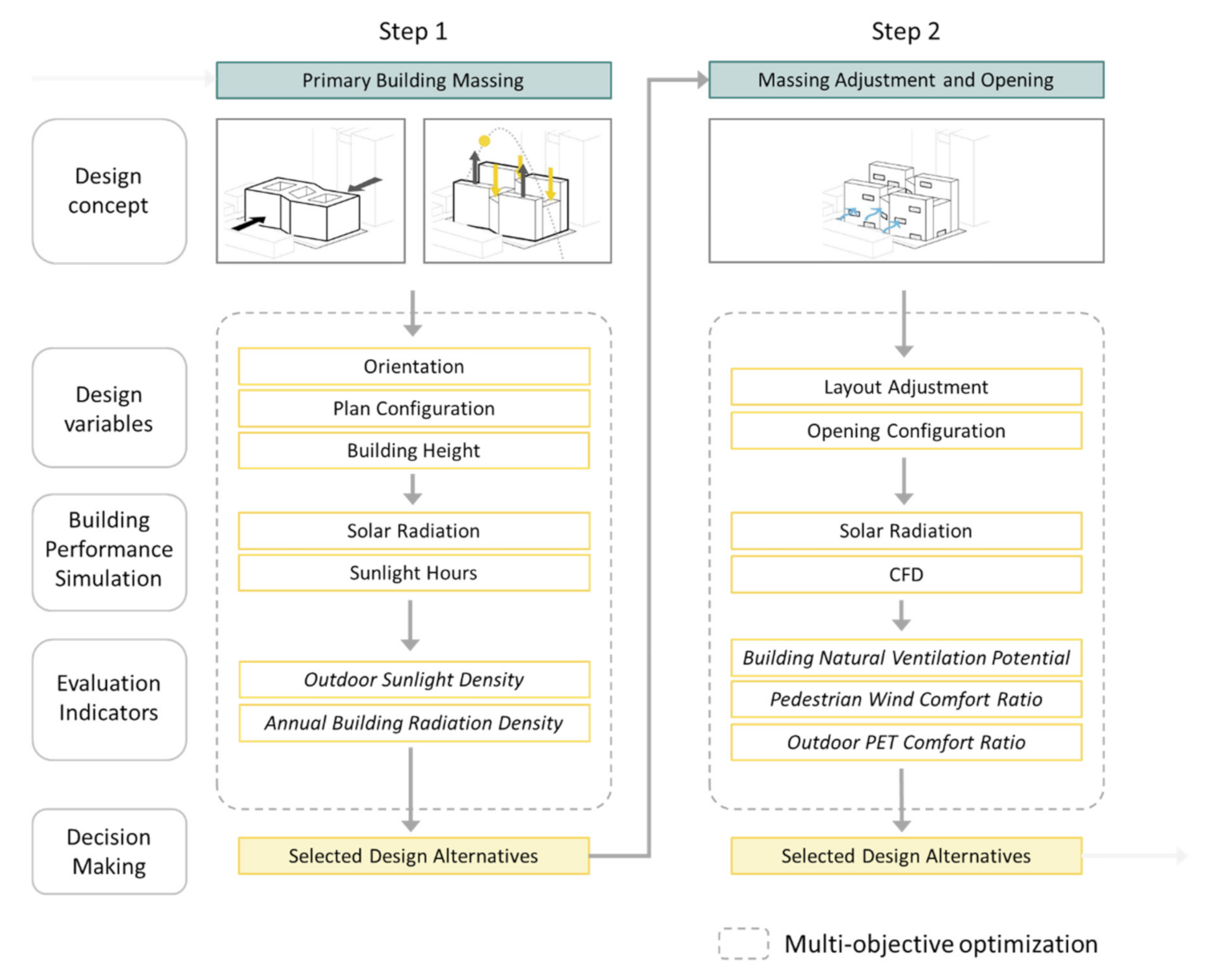
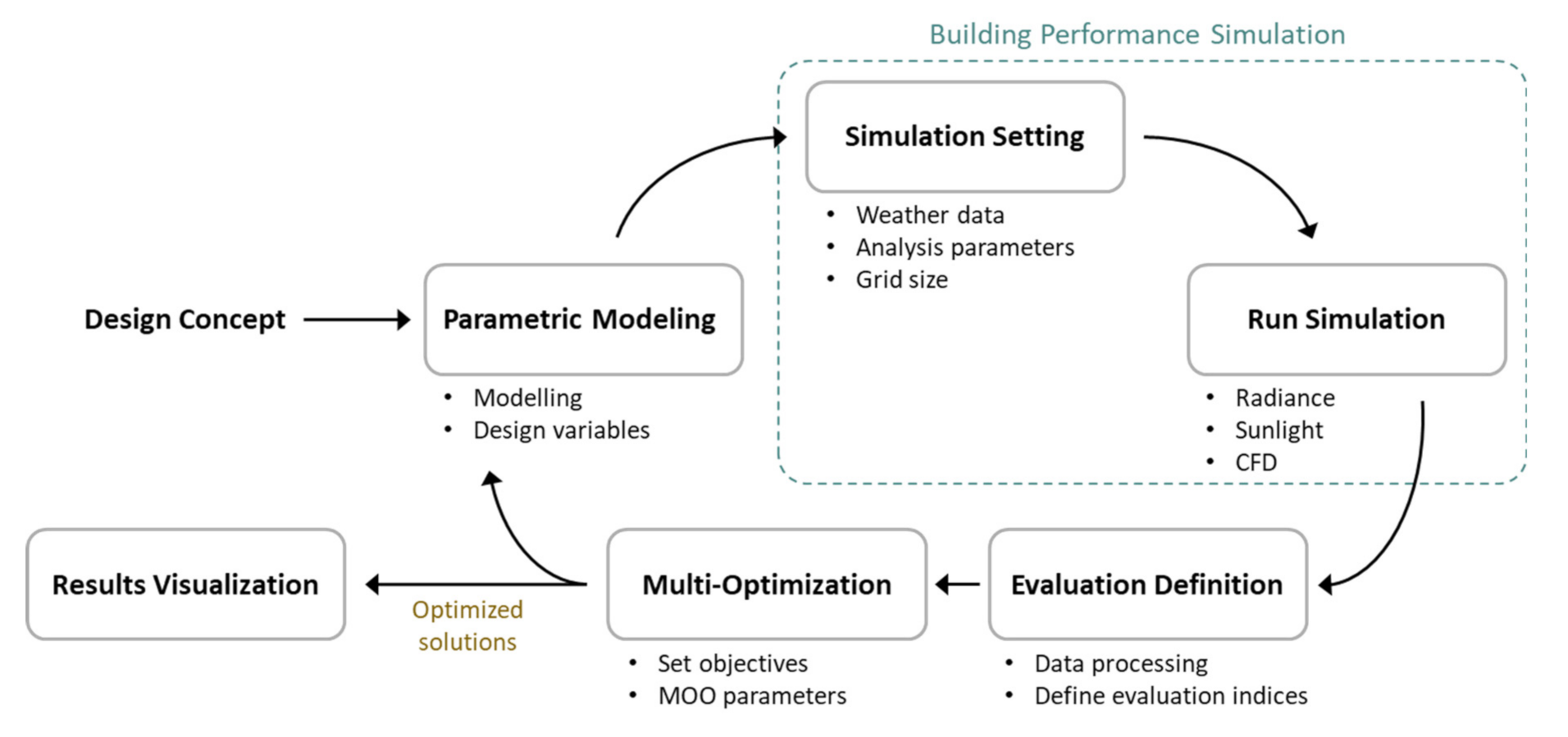
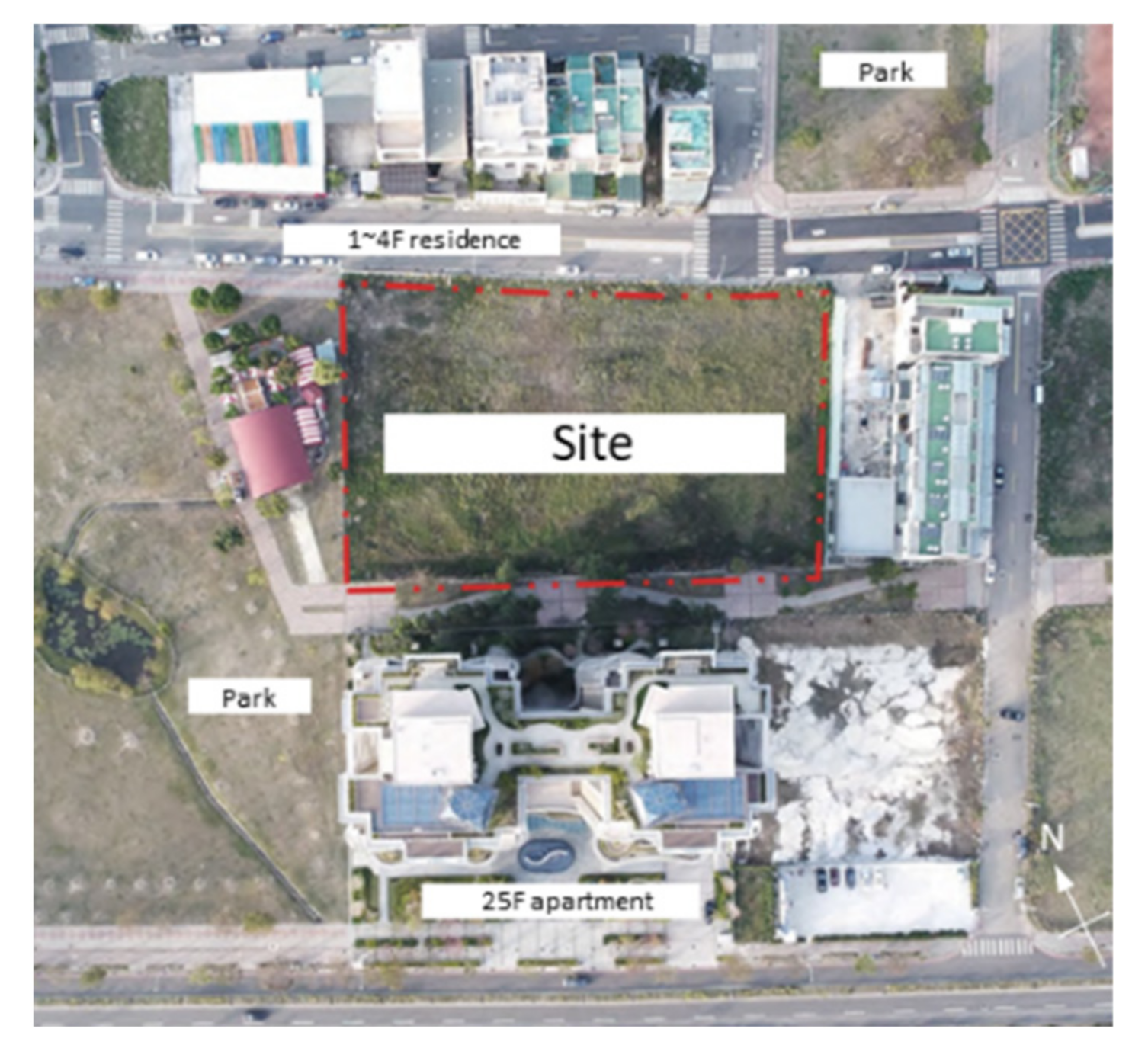
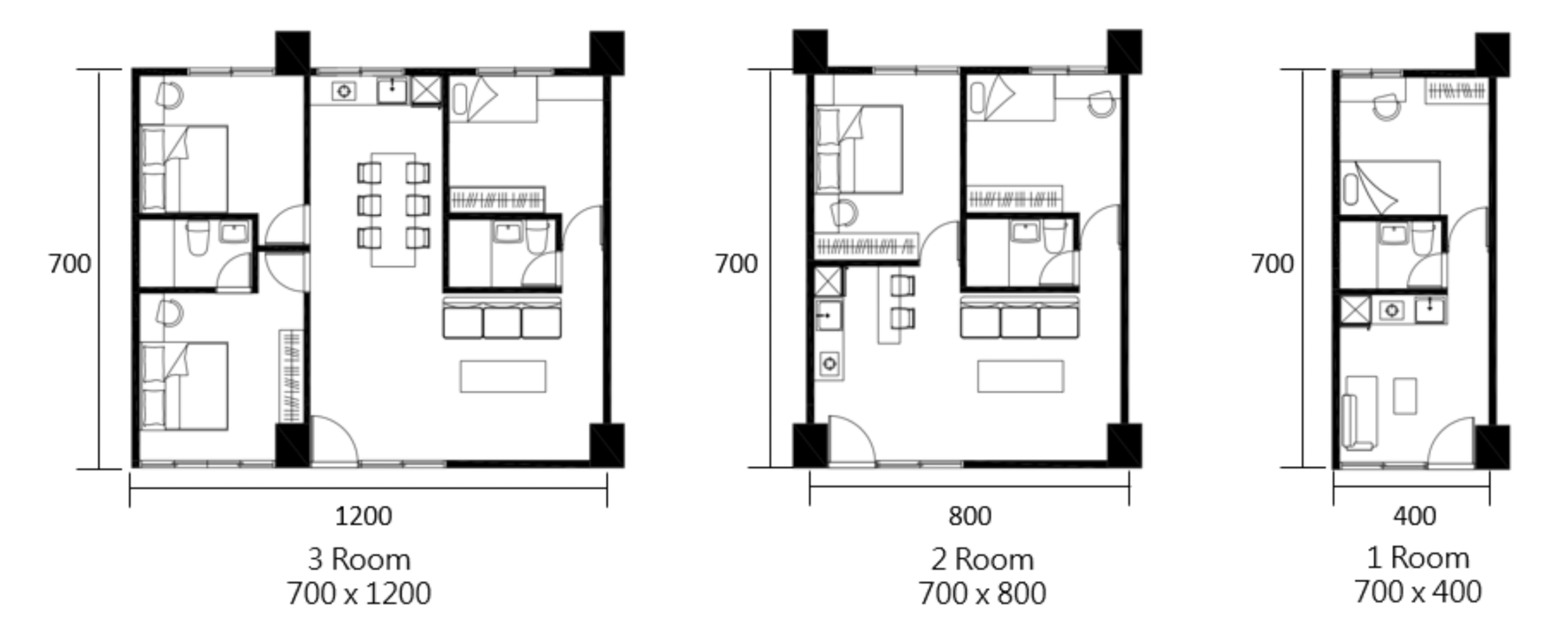



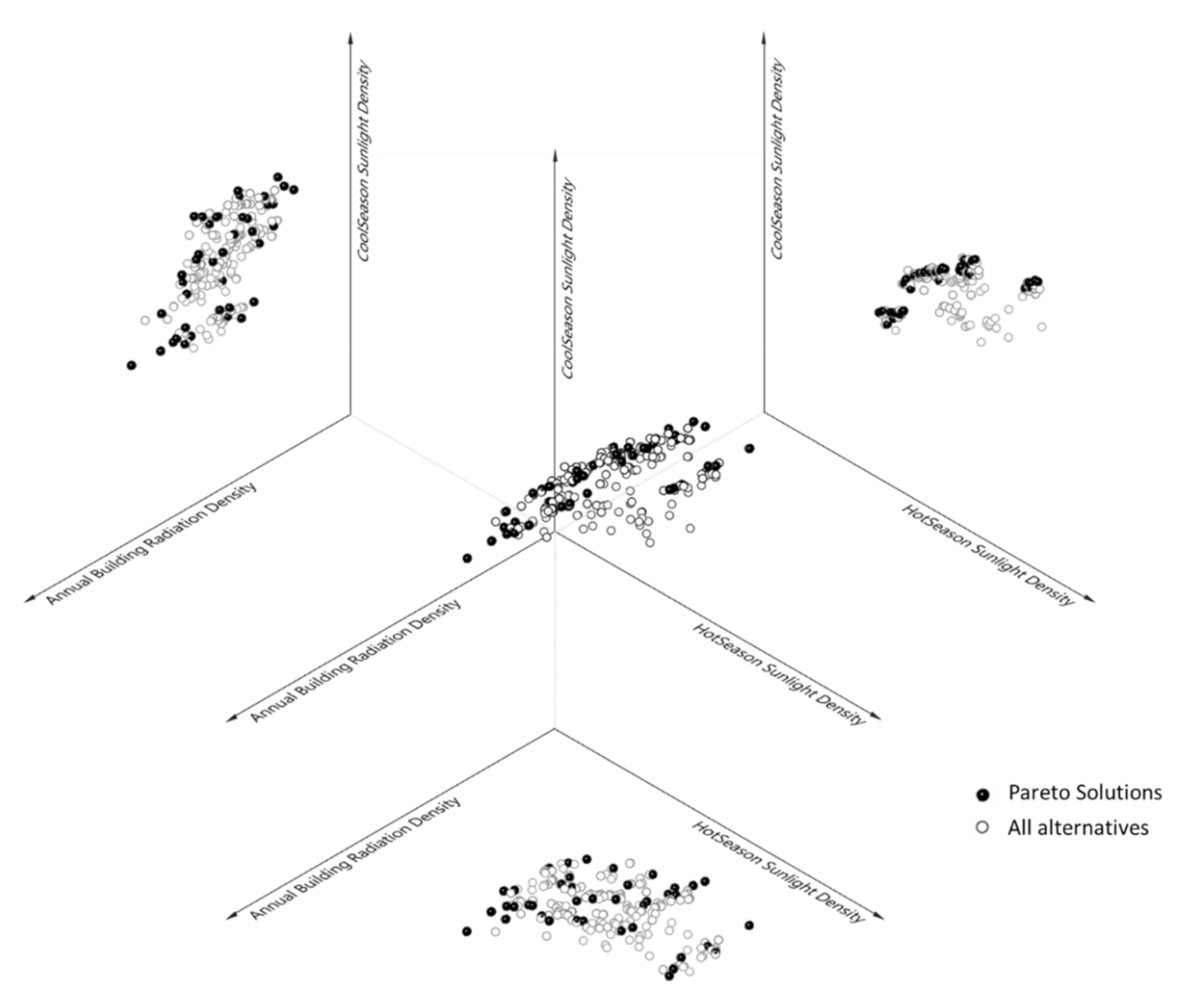
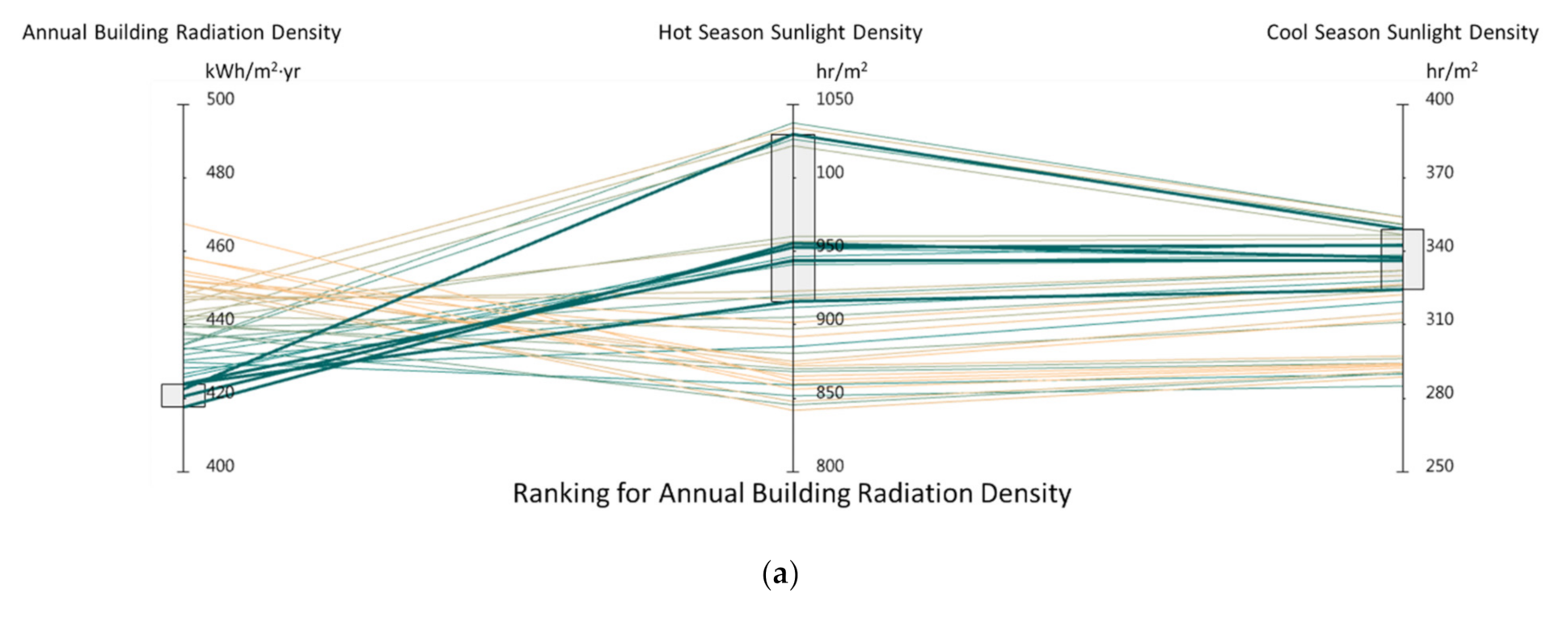



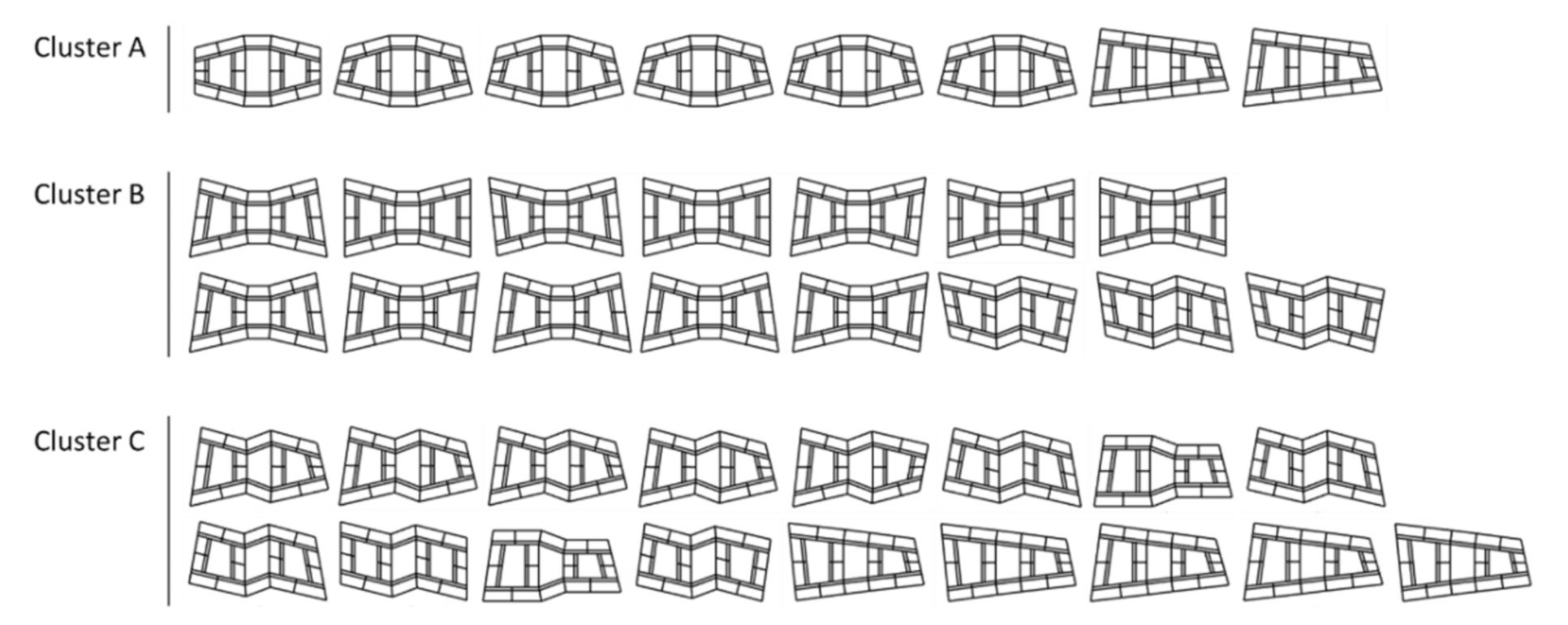
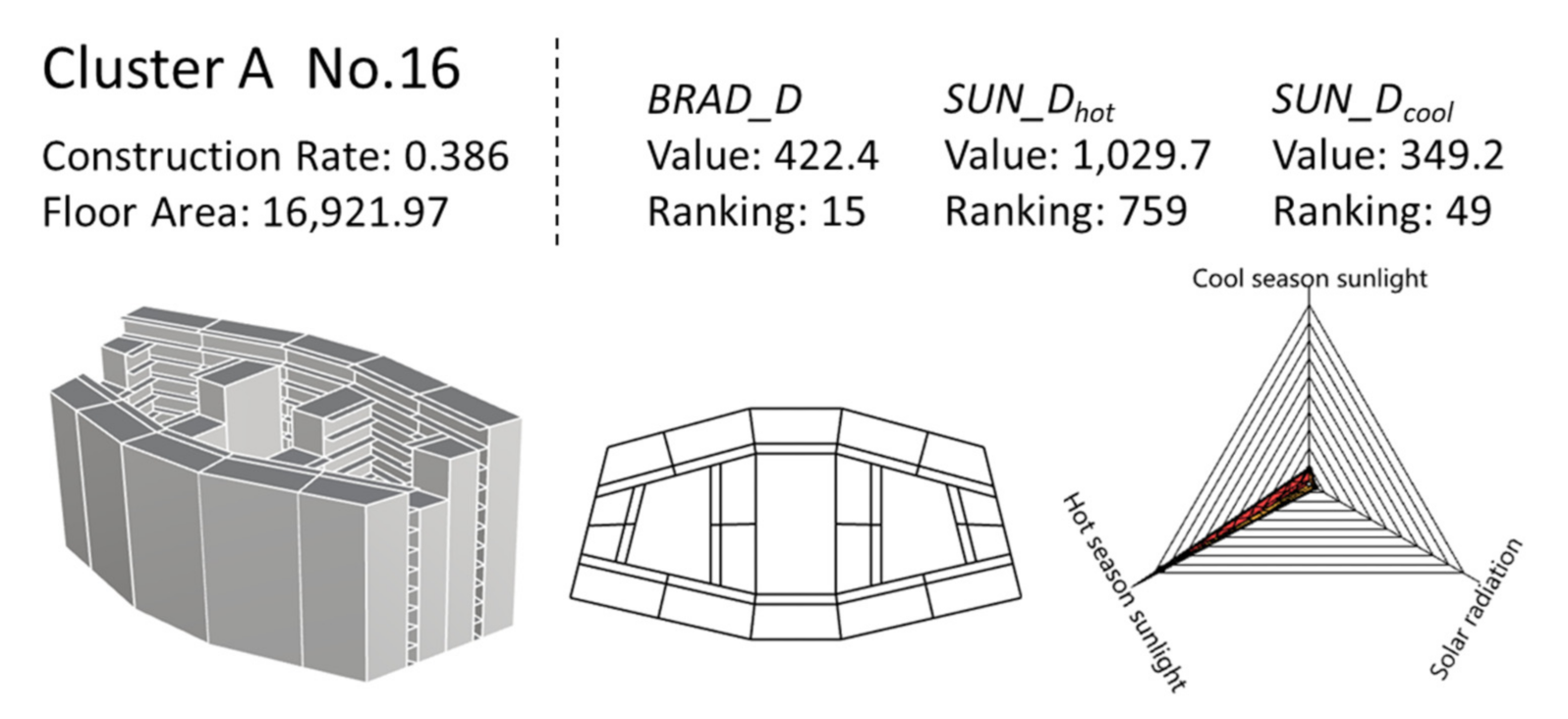
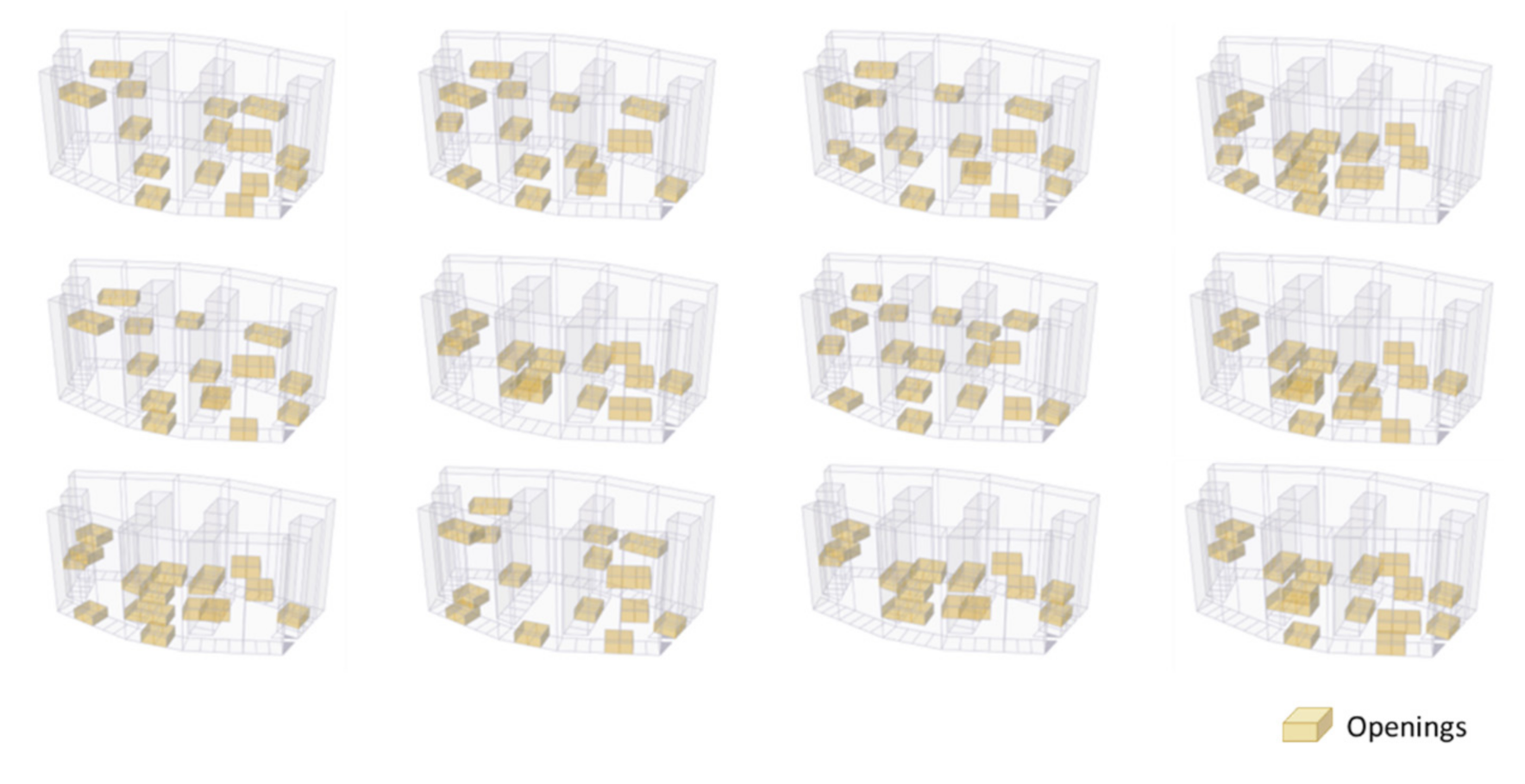

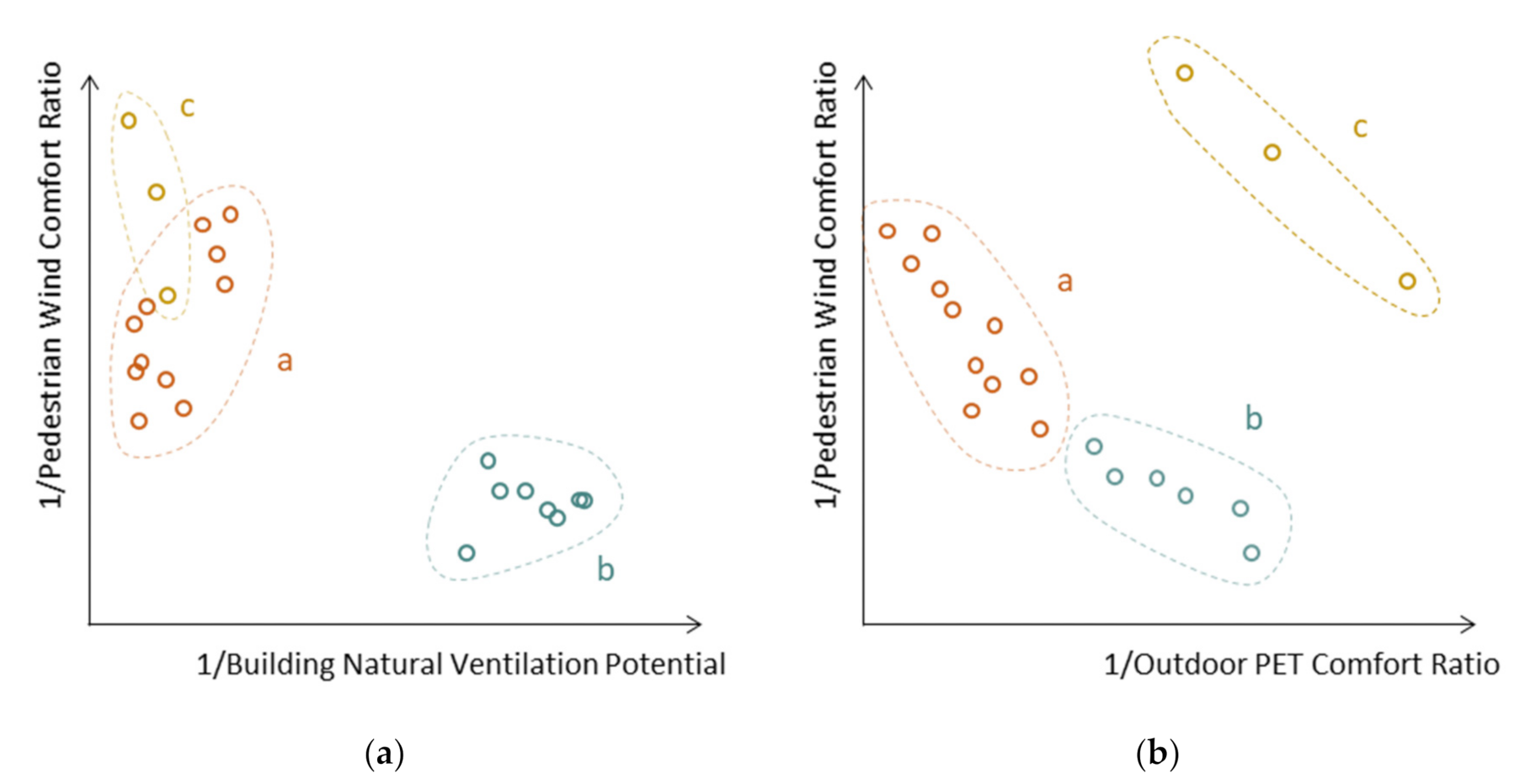

| Months | Most h Temperature | Prevailing Wind | ||
|---|---|---|---|---|
| Direction | Velocity | |||
| Hot Season | 5–10 | >30 °C | North | 2.13 m/s |
| Cool Season | 12–3 | <18 °C | North | 2.15 m/s |
| Indicators | Low Value | High Value | Max Performance Advance | |
|---|---|---|---|---|
| BRAD_D (kWh/m2∙yr) | 417.52 | 467.57 | 50.05 | 12.0% |
| SUN_Dhot (h/m2) | 841.70 | 1042.54 | 200.84 | 23.9% |
| SUN_Dcool (h/m2) | 283.77 | 354.11 | 70.34 | 24.8% |
| Months | Day | Time | |
|---|---|---|---|
| Hot Season | 5–10 | 21 | 7–10, 15–18 |
| Cool Season | 12–3 | 21 | 13–16 |
| Total | 48 h |
| Parameters | Data Source | Change of Value |
|---|---|---|
| Temperature | Weather file (.epw) | Values based on time |
| Humidity | Weather file (.epw) | Values based on time |
| Wind Speed | CFD simulation | Values based on time/grid |
| Sky Cover | Weather file (.epw) | Values based on time |
| Solar Radiation | Ladybug Tools | Values based on time/grid |
| Indicators | Low Value | High Value | Max Performance Advance | |
|---|---|---|---|---|
| BNVP (Pa) | 2.37 | 2.68 | 0.31 | 13.0% |
| PWCR (%) | 39.5 | 76.7 | 37.2 | 94.1% |
| PETCR (%) | 55.5 | 58.6 | 3.1 | 5.6% |
Publisher’s Note: MDPI stays neutral with regard to jurisdictional claims in published maps and institutional affiliations. |
© 2021 by the authors. Licensee MDPI, Basel, Switzerland. This article is an open access article distributed under the terms and conditions of the Creative Commons Attribution (CC BY) license (https://creativecommons.org/licenses/by/4.0/).
Share and Cite
Lin, C.-H.; Chen, M.-Y.; Tsay, Y.-S. Simulation Methodology Based on Wind and Thermal Performance for Early Building Optimization Design in Taiwan. Sustainability 2021, 13, 10033. https://doi.org/10.3390/su131810033
Lin C-H, Chen M-Y, Tsay Y-S. Simulation Methodology Based on Wind and Thermal Performance for Early Building Optimization Design in Taiwan. Sustainability. 2021; 13(18):10033. https://doi.org/10.3390/su131810033
Chicago/Turabian StyleLin, Chuan-Hsuan, Min-Yang Chen, and Yaw-Shyan Tsay. 2021. "Simulation Methodology Based on Wind and Thermal Performance for Early Building Optimization Design in Taiwan" Sustainability 13, no. 18: 10033. https://doi.org/10.3390/su131810033
APA StyleLin, C.-H., Chen, M.-Y., & Tsay, Y.-S. (2021). Simulation Methodology Based on Wind and Thermal Performance for Early Building Optimization Design in Taiwan. Sustainability, 13(18), 10033. https://doi.org/10.3390/su131810033







